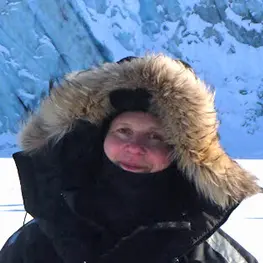AT-819 Shipping in the Arctic (10 ECTS)
ID:
AT-819
CREDITS:
10 ECTS
APPLICATION DEADLINE:
October 01, 2024
START DATE:
April 22, 2025
END DATE:
June 06, 2025
COURSE PERIOD:
Spring semester. Teaching block 3

Ship in front of Storbreen, Hornsund, Svalbard. Photo: Eva Therese Jenssen/UNIS.
| Grade: | Letter grade (A through F) |
| Course Cost: | None |
| Course Capacity Min/Max: | 10/25 students (AT-319/819 in total) |
| Credit reduction / overlap: | AT-319 (10 ECTS) and AGF-319/819 (5 ECTS) |
| Language of instruction: | English |
| Examination support material: | Bilingual dictionary between English and mother tongue |
Course requirements
Enrolment in a relevant PhD programme. Knowledge at bachelor level in one or more of the disciplines: Mathematics, physics, geoscience, biology, engineering, economy, law, or relevant social sciences.
Academic content
The course is interdisciplinary, providing lectures on climate, sea ice, weather, environment, navigation, technology (including vessel types, winterization, green energy, digitalization), infrastructure (harbours, communication, services), economy, regulations, and geopolitics related to shipping in the Arctic. The lectures will address how the human factors combined with the natural environment have impact on shipping activities. The different actors involved in the specialized fields and how they interact with each other will be presented. The lectures will give a historic summary, a present state-of-the-art and future perspectives of Arctic shipping from a multidisciplinary perspective.
Learning outcomes
The students will have attained advanced interdisciplinary knowledge about the factors that determine types, quantities and routes of Arctic ship traffic. The course shall give the students deeper academic understanding of how climate, environmental, and socioeconomic drivers have impact on shipping in the Arctic where sea transportation is expected to grow in the future. The reduction of the Arctic sea ice and the demand for energy gives new opportunities for shipping routes between Europe, Russia, Asia, and North America. Especially, the exploitation of hydrocarbon and other resources as well as tourism and scientific exploration generate more ship traffic in Arctic regions. The presence of sea ice, darkness, limitations of bathymetric charts, lack of infrastructure and communication services put severe limitations on how ships can operate. The students will attain advanced knowledge on how shipping is constrained by regulations, environmental risks, economic risks and geopolitical situations.
Upon completing the course, the students will:
Knowledge
have obtained forefront knowledge about the factors that determine the shipping activities in the Arctic. These include:
- economic factors related to resource exploitation and global/regional sea transport routes
- environmental factors related to climate, sea ice and weather conditions, as well as pollution related to ship traffic
- technology (vessel types, winterization, green energy, digitalization) and infrastructure (harbours, communication, services) required for ships operating in the Arctic
- regulatory and geopolitical considerations, including the Polar Code
- assessment of risks and opportunities related to ship traffic.
The course will provide forefront knowledge of how these factors will determine the evolution of Arctic shipping in shorter and longer perspective.
Skills
- have learned skills to analyze development of Arctic ship traffic at the present time and what is expected in the future
- have learned to extract and combine information from different scientific disciplines about the factors driving the ship traffic as well as limiting the ship traffic. This skill will be used to analyze a set of research problems and write a scientific report on selected topics within the course plan.
- have learned to assess pros and cons regarding ship traffic in the Arctic, based on the factors described in the knowledge section above
- have skills to use relevant methods to carry out independent and forefront research on multidisciplinary topics related to Arctic shipping.
General competences
- have obtained competence to analyze research problems on Arctic shipping within and beyond the topics addressed in the course
- have gained competence to carry out independent research on a wider scope of multidisciplinary topics
- have competence to write scientific reports and publications about Arctic shipping topics
- have competence to generate new ideas and research questions
- have competence to communicate with specialists as well as the general public.
Learning activities
The course extends over ca 6 weeks including compulsory safety training, and is run in combination with AT-319.
- Lectures and seminars: to cover key topics related to shipping in the Arctic, such as environmental challenges, laws, technology, and safety. Guest speakers from the shipping industry or research community may give talks to provide insights into current issues and developments.
- Exercises and Case Studies: to analyze real-life examples of shipping operations in the Arctic (mapping, AIS, remote sensing, POLARIS). This helps in understanding practical challenges and strategies used in the industry.
- Group Work: to solve problems and develop strategies related to Arctic shipping. This fosters teamwork and improves problem-solving skills.
- Field Trips (excursion): to relevant Arctic locations or ships, giving you first-hand experience. These trips vary each year, depending on what’s available, but they usually include visiting vessels, the Longyearbyen Harbor, Search and Rescue Facilities, companies involved in shipping activities.
- Projects and Presentations: to explore a specific aspect of shipping such could include environmental, economic, or technical issues, related to Arctic regions. Students will present the findings to the class, improving the communication skills.
Summary
- Total lecture hours: 45 hours
- Total seminar hours: 25 hours
- Exercise hours: 30 hours
- Excursions: 10 hours
- Report writing: 50 hours
- Self study: 100 hours
Compulsory learning activities
- Seminars, assignments, field excursions, presentations.
All compulsory learning activities must be approved to attend the exam.
Assessment
| Method | Percentage of final grade |
| Project report / presentation | 50% |
| Oral exam | 50% |
All assessments must be passed in order to pass the course.
Each assessment is graded and subsequently combined into a single grade. Partial grades for each assessment will be available.
Student life

